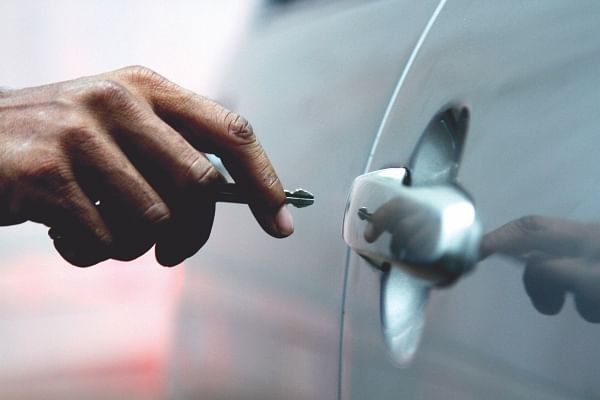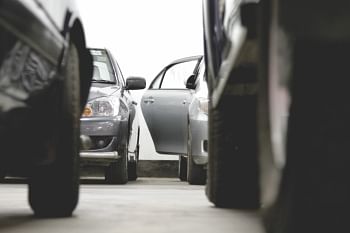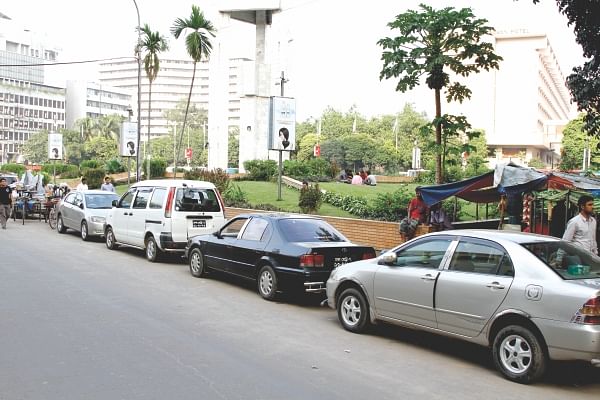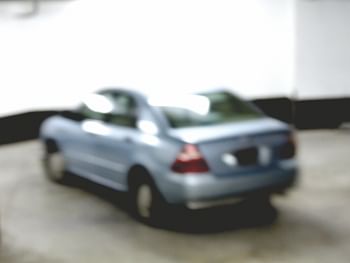| Home - Back Issues - The Team - Contact Us |
 |
| Volume 10 |Issue 41 | October 28, 2011 | |
|
|
Special Feature
The Art of Carjacking Carelessness of owners, complicity of the drivers with gangs have made carjacking one of the easiest crimes to commit Tamanna Khan Every night, when my mother sends the car to pick me up from office, she calls urging me to inform her as soon as the vehicle arrives at the office premise. Annoyed, I often question her worries about the car. What can possibly happen to a recently purchased X-Corolla, 2006 model? Mohammad Mokhlesur Rahman, Senior Assistant Police Commissioner, Detective and Criminal Intelligence Division (South) and Team leader of Vehicle Theft Prevention and Recovery Team provides the answer. In a country, where most of the private vehicles are driven not by the owner but by a paid chauffeur, carjacking often takes place with direct involvement of the driver. Members of organised groups of carjackers, take up driving jobs using fake driving license and ID cards, Rahman explains.
“During his employment tenure, he forges a duplicate key of the car. At one point, after a few months have passed, he informs his employer that he will not continue the job and leaves,” he narrates. Rahman adds that since the con-driver is already familiar with the movement of the car, he knows at what time of the day it remains unattended. So at an opportune moment he can easily break inside the vehicle and drive it away into the safe haven of the carjackers. Rahman says that since most car thieves posing as drivers come from needy families, they are often tempted to sell the car to illicit buyers willing to purchase stolen cars. In that case, the driver may not be a member of a carjacking gang but steals the car anyway taking advantage of his employer's trust. In fact, Md Salim, a businessman living at Dhanmondi, had no reason to suspect the newly recruit he had employed towards the end of May 2011, to drive his Toyota Allion, 2002 model. He had advertised for a driver through a newspaper and the driver had applied with a curriculum vitae along with copies of his national ID, school certificate upto class eight, driving license, and an old coloured photograph. “He said he had worked in Saudi and was not in good terms with his family,” recalls Selim, adding that he did not ask for any further reference after that. “On July 24, 2011, at around 10 am, I went in my car for a check-up at Square Hospital. When I came out around 1 pm, I called him on his cell phone to bring the car out but he was not answering,” recounts Selim. At that moment, it hardly occurred to him that his car could be stolen. “That very morning he had taken the car alone to receive my relatives from the airport. So when he was not answering, I guessed that he might be sleeping inside the car,” Salim explains. When he finally realised what had happened, he immediately informed metropolitan police and a high official at Detective Branch of police. His son went to check the local address of the driver while another person went to the driver's village home, but neither the driver nor the car could be traced.
Fortunately, Salim had contacts at a telecommunication company, who informed him that although the driver had closed the previous SIM of his mobile phone, he did not change the set and had applied for a new SIM. As a result it was possible to know about his movements. On August 9, the driver activated his old SIM and both the old and the new SIM were located near a mobile tower in Sylhet. The official from DB informed Salim about the recovery of the vehicle and the arrest of the driver on that very night. “When I met him the following day, I was stunned. He had a completely different look. His beard was gone and I could not match the young, clean-shaved, well-dressed man in gabardines with the man who worked for me in a shabby Kabuli dress for the last two months,” says a baffled Salim. He learned from the Vehicle Theft Prevention and Recovery Team that the driver had sold his car at a garage in Uttara for Tk 12 lakh. The garage owner in turn had sold the vehicle for Tk 15 lakh 75 thousand to another private buyer at Uttara. The driver claimed that he was the owner of the car and had shown a sales contract on a Tk 400 stamp to the garage owner with the forged signature of his former employer, Salim. He also had a copy slip issued by Bangladesh Road and Transport Authority (BRTA), which Salim had mistakenly left in the car. “I had changed the colour of my car and applied for it to BRTA on May 12. Keeping the blue book and other documents for processing, BRTA had issued a copy slip for use on the roads,” explains Salim. He admits that he made another mistake by not informing BRTA as soon as his vehicle got stolen.
While Salim's driver ran off with the car, Lutfur Rahman's driver had a different story to tell. His reconditioned S-Corolla 2006 brought for Tk 16 lakhs 3 thousand on January was hijacked on September 14, 2011. “My office is at Motijheel near the Biman office. The car is usually parked on the street in front of Shahajalal Bank along with many other cars of office executives,” he says, mentioning that the security guards of the bank as well as the one of Karim Mansion remain in vigilance till 7 to 8 pm at night. “That day I came down from my office at 6:30 pm and called my driver but could not get a connection. Trying to contact him until 8:30 pm, I went to the police station and filed a general diary,” he continues, “At around 10 pm, I received a message from an unknown number that said that carjackers had thrown my driver in a field near Keraniganj.” When he went to see him at Dhaka Medical College later that night, the driver was unconscious. Although it appears that the driver was drugged by carjackers, Lutfur Rahman thinks that the driver's statement is inconsistent. On the day of the hijack, the driver had parked the car elsewhere and he could not justify why he did so. According to the driver's statement, two men had entered the car and injected him with something, while another drove the car away. Then why did they take him along with them all the way to Keraniganj? Since the truth about the carjacking incident could not be confirmed Lutfur had retained his driver keeping a watchful eye on him. In fact, it is often the driver's negligence that gets the vehicle stolen. “Drivers driving alone, especially at night, around 10 to 11 pm, take unknown passengers in their cars to earn an extra buck. Often these passengers happen to be carjackers,” Rahman says adding that most of the incidents occur under Mohakhali flyover and at the Shahbag crossing.
Rahman describes another technique: drivers waiting in parking lots fall prey to carjackers, pretending to be aspiring drivers, who approach drivers to take driving lessons in exchange for money. The carjackers then convince the drivers to get on less busier roads. There their accomplices wait with drinks that have already been prepared with 10 Ativen tablets (a Pakistani sleeping pill). They offer the drinks to the drivers and once the drivers black out, the carjackers drive off with the car. Mohammad Mintu, a professional carjacker, however, did not have to use any of the above tricks for carjacking. Shohag, his accomplice, provided him with a master key and all he had to do was walk to an unattended car parked on a street in Motijheel or Shahbag, open the door, start the engine and drive away the car in broad daylight. Mintu, convicted for stealing both cars and motor cycles, has been involved in the trade for the last four years. “I mostly carjacked second-hand cars of the 90s model and the 90-100 Corollas,” he informs. After stealing the car, Mintu would take it to Shohag sometimes at Dholaikhal, sometimes at Jatrabari, and receive Tk 30,000-40,000 within a week. He says that the cars are used for transporting phensedyl from Benapole, Jessore to other places. “They never use rented cars for this purpose,” informs Mintu.
Rahman points out that amongst property thefts, stealing cars and other vehicles is the easiest as it involves a moveable item. “It is a matter of seconds before the car can be driven out of sight outside the city,” he remarks. Besides, car thieves usually possess a stack of fake number plates, which they change on their way to the next destination. Therefore, traffic police cannot possibly identify the runaway vehicle when informed of the theft over their walkie-talkies. Thankfully, the Vehicle Theft Prevention and Recovery Team, formed in 2008, have access to modern technology with which they can investigate individual cases and track down carjacking gangs. Highlighting the negligence on the part of car owners and the drivers, Rahman says, “It is an irony that we do not trust someone with Tk 50,000 but we naively trust a stranger with a property worth Tk 10-15 lakhs.” In a country where all that a traffic police possesses is a baton and the police stations with their archaic vehicles, too slow to chase down the carjackers, the responsibility of the car owners undoubtedly multiplies. A little more awareness on our part can actually reduce the 40-50 vehicle hijacking cases reported each month.
Copyright
(R) thedailystar.net 2011 |





 Mohammad Mokhlesur Rahman confirms Mintu's information saying that beforehand many showrooms used to buy stolen cars. However, after a few arrests, that has stopped. Now the majority of the buyers of stolen cars are drug dealers, he says. He adds that, buying a stolen vehicle for 1.5 to 3 lakhs taka rather than renting one for 60 thousand taka per trip, is cost effective for drug dealers.
Mohammad Mokhlesur Rahman confirms Mintu's information saying that beforehand many showrooms used to buy stolen cars. However, after a few arrests, that has stopped. Now the majority of the buyers of stolen cars are drug dealers, he says. He adds that, buying a stolen vehicle for 1.5 to 3 lakhs taka rather than renting one for 60 thousand taka per trip, is cost effective for drug dealers.